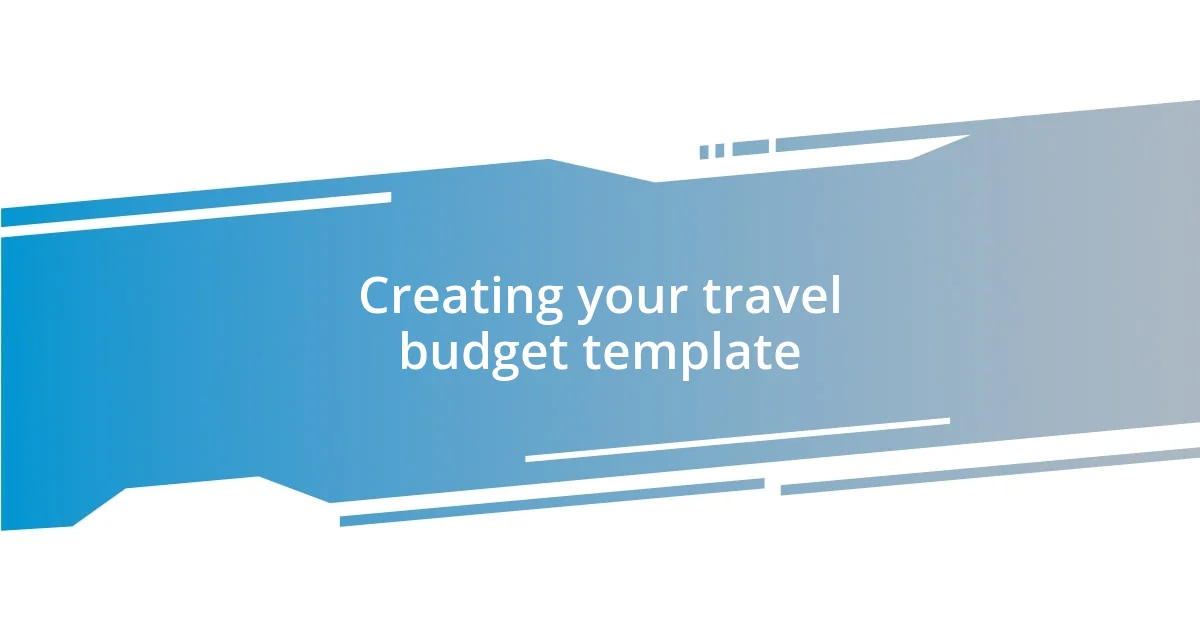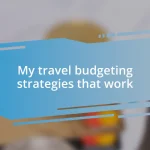Key takeaways:
- Effective travel budgeting involves categorizing expenses (transportation, accommodation, food, activities) and setting aside a contingency fund for unexpected costs.
- Setting realistic budget goals is essential, including assessing past trips, prioritizing experiences, and being flexible with expenditures.
- Tracking expenses in real-time using apps or visual logs helps manage budgets and identify spending patterns, enhancing overall travel experiences.

Understanding travel budgeting concepts
Understanding travel budgeting is all about knowing where your money goes and how to make it stretch. I still remember my first trip abroad when I didn’t create a budget—it was chaotic! By the end of the trip, I found myself scrambling to fund my return home. Have you ever felt that panic when your funds are running low? It’s an experience I learned from, and it really opened my eyes to the importance of planning.
When we talk about travel budgets, it’s essential to categorize your expenses effectively. I like to divide my costs into key areas: transportation, accommodation, food, and activities. This approach helps me see where I can cut back without sacrificing enjoyment. For instance, on a recent trip, I shifted from costly restaurants to charming street food vendors, discovering delightful local flavors while saving money. Have you noticed how trying local foods can enhance your travel experience without breaking the bank?
Another crucial concept is setting aside a contingency fund. I once set aside a small amount each week leading up to my trip, and when unexpected expenses arose—like a sudden train delay—it saved me from stress. It’s like having a safety net that allows you to embrace spontaneity during your travels. How would it feel to have that peace of mind knowing you’re prepared for the unexpected? Trust me, it makes all the difference in enjoying your journey!

Setting realistic budget goals
Setting realistic budget goals is fundamental to having a stress-free travel experience. I’ve learned, sometimes the hard way, that it’s crucial to define clear and attainable financial targets. For instance, on my last backpacking trip, I set a budget of $50 a day, which seemed reasonable at first. However, I quickly realized that I hadn’t factored in costs like entry fees for attractions or the occasional splurge on a nice dinner. This miscalculation made me tighten my belt in other areas, which was less enjoyable than I’d hoped.
Here are some tips to set effective budget goals:
- Assess past trips: Look at how much you spent previously and identify patterns. Did you overspend on accommodations or excursions?
- Prioritize experiences: Decide what activities matter most to you. Allocate more of your budget to experiences that will bring joy and less to those you enjoy less.
- Break it down: Divide your overall budget into daily budgets. It’s easier to stay on track when you know exactly how much you can spend each day.
- Be flexible: Allow yourself room to adjust. If you really want to try that gourmet restaurant, consider cutting back on activities that day.
- Track as you go: Use an app or keep a journal to monitor your expenses throughout your trip. It helps you stay within budget and avoid unpleasant surprises.
By setting realistic budget goals, you can enjoy your journey without the nagging worry of finances overshadowing your experiences.

Researching destination costs effectively
Researching destination costs effectively can truly make or break a travel budget. I remember planning a trip to Southeast Asia, and I was amazed by how varied the prices could be, even within the same country! Utilizing online resources, such as travel forums and budget-travel blogs, allowed me to get a real sense of what to expect, helping me avoid tourist traps that could inflate costs. What tools do you rely on for your destination research? It’s essential to dig deep; sometimes the best insights come from travelers sharing their recent experiences.
Additionally, I’ve found that leveraging social media can be a game-changer. Following local influencers or travel accounts specific to your destination can provide up-to-date information on current costs, hidden gems, and even seasonal deals. During my trip to Barcelona, a recommendation from a local Instagrammer led me to a quaint café offering delicious meals at half the price of the touristy spots. Have you ever stumbled upon a great find simply from a post? It’s those unexpected discoveries that add real value to our travel experiences.
Lastly, I always factor in the currency exchange rate, as it can substantially affect my overall budget. When planning a trip to Europe, I closely monitored the Euro’s fluctuation for weeks. I once missed a significant dip in the exchange rate, which taught me to keep an eye out well in advance. Have you ever had to alter plans because of currency issues? Being informed empowers you to make better choices, ensuring your travel budget remains sustainable and responsive to market changes.
| Resource Type | Benefits |
|---|---|
| Travel Blogs | Offer practical advice and recent personal experiences |
| Social Media | Provides current insights and local recommendations |
| Travel Forums | Facilitates discussions with fellow travelers about cost expectations |
| Currency Converters | Helps track exchange rates effectively |

Creating your travel budget template
When creating your travel budget template, I always start by listing all the potential expenses. This includes everything from accommodations and meals to transportation and activities. On my recent trip to Italy, I wrote down each category and anticipated costs. I quickly realized that my dream of dining in a Michelin-starred restaurant required a larger allocation than I’d expected. Have you ever underestimated how much certain experiences would cost?
Next, I recommend using a spreadsheet or budgeting app to keep track of your estimated versus actual expenses. When I tried a budgeting app during a European backpacking adventure, I loved how it provided a clear visual of my spending habits. It helped me identify areas where I could cut back without sacrificing enjoyment. By logging expenses daily, I found that I was more mindful of my purchases, leading to more spontaneous adventures that didn’t break the bank.
Lastly, I believe it’s important to revisit and adjust your budget throughout your trip. Life happens, right? I remember one night in Thailand when a local festival popped up, and I couldn’t resist joining in the festivities. Although it was an unexpected expense, it was one of the most memorable nights of my travels. I quickly adjusted my budget for the week, showing me how flexibility can lead to enriching experiences. What adjustments have you made in the past that turned out to be worth every penny?

Tracking expenses during the trip
Tracking expenses during the trip is something I take very seriously, and I’ve found that using my phone to jot down every single purchase makes a world of difference. During my last adventure in Japan, I downloaded an expense tracker app that allowed me to categorize expenses instantly. This habit not only kept me on course financially but also revealed patterns in my spending that I hadn’t noticed before. Have you ever been surprised by where your money goes while traveling?
Proof of my success in tracking expenses came during a week-long stay in Thailand. On one particularly busy day of exploring, I didn’t log my lunch expenses right away. By evening, I was baffled to discover that I had spent a lot more than I anticipated! I had planned to splurge on a special dinner, but I had unintentionally drained my budget on impulsive snacks. Remembering to track expenses in real-time is essential. It turns this sometimes mundane task into a simple daily habit that pays off.
One technique that works wonders for me is creating a visual expense log. I often find it helpful to snap photos of receipts and add them to a shared album. This way, not only do I have a digital record, but I also collect memories as I go. Last summer in Portugal, I did this during a wine tasting tour. Looking back, I didn’t just see costs; I was reminded of indulgent moments that brought joy. Have you tried something similar? These small practices truly help me stay connected to my spending, making sure it aligns with my travel experiences.














